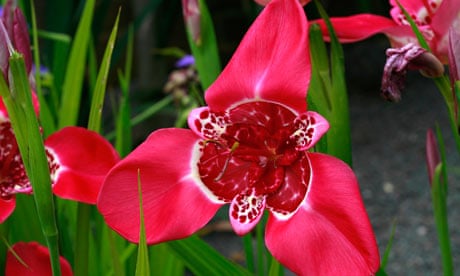I garden, write and think with my stomach. I guess that's obvious by now. Sure, every now and then I throw in an ornamental, but always, deep down, I'm just thinking of lunch. So imagine my great joy when I am alerted to something decidedly ornamental – a pretty, frivolous sort of bulb that is cheap and cheerful – that at the end of the season you get to eat. You get your money back with this one.
The Tiger flower, Tigridia pavonia, is a native to Mexico and was an ancient food of the Aztecs, known as cacomitl. Those intrepid enough to try the very unusual say that, when roasted, the bulbs taste somewhere between a sweet potato and a sweet chestnut. I'm already dreaming of marrying them up with brussels sprouts.
The flowers come in shameless acid shades of yellow, pink and red, and last for just a few days. Each bulb produces six to eight flowers, opening in succession and appearing around the long, thin, sword-like leaves. They look quite otherworldly.
Back home, they grow in grassland on thin soils and are said to be frost-tender, but there are many reports of them surviving temperatures as low as -8C and not minding wet conditions. I think the trick is to plant them in very free-draining soil (mix plenty of grit or sand into shop-bought compost), so they don't sit in the wet come winter. Make sure you get the bulbs down deep enough (7-10cm) and, say, 5cm apart.
I'm going to grow mine in pots so that, come winter, I can store them somewhere dry and frost-free if necessary. Plus, while I'm not sure how to work fuchsia pink into my more muted colour scheme in the garden, on the patio anything goes.
You can plant them right now – you'll find them in the bulb section in lurid packaging for around £2.49 – or sow seeds. They will need a warm, sheltered spot in full sun and are perfect for that baked patio or sunny dry corner. They'll germinate easily enough now on a warm windowsill (they want 13-18C) and will start flowering in their second year from seed. They are quite prone to self-seeding around if they are happy.
You harvest any offsets for eating while the plants are dormant (from autumn to spring). It is not advisable to eat shop-bought bulbs for at least one season as a form of detox – these were not grown with supper in mind.
If I've not convinced you to try eating them, then grow them as a cheap, colourful filler for those gaps left behind by May and June flowers such as poppies and aquilegias. If you are going to do this, it's easiest to start them off in pots (cram them in) and plant out just before they flower.
Alys on... Nigella
Sow love-in-a-mist, Nigella species, now in bare patches near the front of a border. They make lovely cut flowers, and lasta surprisingly long time in the vase. Save some for their pretty seed heads. Nigella damascena seeds are edible and can be used in cooking and baking, giving a gentle nutmeg flavour to cakes and breads.
Sow the seeds in a bare patch in the ground; scatter liberally, cover with just a little soil and water in. Plants can then be lifted and spaced to as wide as 15cm apart (necessary if you want longer stems for the vase) or leave them to fight it out. If you have a clump that has self-sown from last year, thin it out over the next few weeks, transplanting the spares. They'll start flowering in eight to 10 weeks and continue for much of the summer.
N. damascena will happily self-seed. There are many cultivars, in colours from white to pink. The semi-double 'Miss Jekyll', in powdery blue, is one such showy number, but it doesn't flower for as long as the straight species.
Flower-arranging types should try N. papillosa or N. papillosa 'African Bride'. The former is deep purplish-blue with wonderful dark velvet stamens and spidery seedpods; the latter is dusky white, again with luxurious red stamens.

Comments (…)
Sign in or create your Guardian account to join the discussion